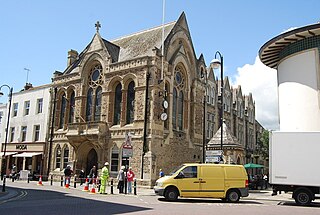
Royal Tunbridge Wells is a town in Kent, England, 30 miles southeast of central London. It lies close to the border with East Sussex on the northern edge of the High Weald, whose sandstone geology is exemplified by the rock formation High Rocks. The town was a spa in the Restoration and a fashionable resort in the mid-1700s under Beau Nash when the Pantiles, and its chalybeate spring, attracted visitors who wished to take the waters. Though its popularity as a spa town waned with the advent of sea bathing, the town still derives much of its income from tourism.

Decimus Burton was one of the foremost English architects and landscapers of the 19th century. He was the foremost Victorian architect in the Roman revival, Greek revival, Georgian neoclassical and Regency styles. He was a founding fellow and vice-president of the Royal Institute of British Architects, and from 1840 architect to the Royal Botanic Society, and an early member of the Athenaeum Club, London, whose clubhouse he designed and which the company of his father, James Burton, the pre-eminent Georgian London property developer, built.

The Borough of Tunbridge Wells is a local government district with borough status in Kent, England. It takes its name from its main town, Royal Tunbridge Wells. The borough also contains the towns of Paddock Wood and Southborough, along with numerous villages and surrounding rural areas. Large parts of the borough fall within the High Weald Area of Outstanding Natural Beauty.

The Hazlitt Theatre and Exchange Studio, also known as the Hazlitt Arts Centre, is a theatre complex in Earl Street in Maidstone, Kent, England. The oldest part of the complex, which is now used as a shopping complex on the ground floor, and as a theatre venue known as the "Exchange Studio" on the first floor, is a Grade II listed building.

Trinity Theatre is a theatre and arts centre, located in the former Holy Trinity Church in the centre of Royal Tunbridge Wells, Kent.

St Paul's Church is a Church of England parish church in Rusthall, Kent, England. It is a Grade II listed building.

Watford Town Hall is a municipal building in Rickmansworth Road, Watford, England. It is a Grade II listed building.

Crown House is a residential building on the seafront of St Leonards-on-Sea, a 19th-century planned seaside resort on the coast of East Sussex, England. It was the first building completed in the town, which was planned and laid out by architect and property developer James Burton, and he used it as his own house. Intended as "a high-class watering place by the sea, along the best lines [and] for the best people", St Leonards-on-Sea was overshadowed by its larger neighbour Hastings and was merged into that town before the end of the 19th century, but Burton's venture was initially successful—particularly after a Royal visit in 1834–35 when the Duchess of Kent and the future Queen Victoria stayed at Crown House throughout the winter.

Macclesfield Town Hall is a Georgian municipal building in the Market Place of Macclesfield, Cheshire, England. Dating originally from 1823–24, it was designed by Francis Goodwin in the Greek Revival style, and extended in 1869–71 by James Stevens and again in 1991–92. The building incorporates the former Borough Police Station. The town hall is listed at grade II*.

Greenwich Town Hall is a municipal building on Royal Hill, Greenwich, London. It is a Grade II listed building.

Acton Town Hall is a municipal building in High Street, Acton, London, England. It is a Grade II listed building.

High Wycombe Town Hall is a public building located on Queen Victoria Road in High Wycombe, Buckinghamshire, England. The building, which is used as an events venue, is a Grade II listed building.

The Harrogate Council Offices is a municipal building in Crescent Gardens in Harrogate, North Yorkshire, England.

Bootle Town Hall is a municipal building in Oriel Road in Bootle, Merseyside, England. The building, which is the headquarters of Sefton Council, is a Grade II listed building.

Cleckheaton Town Hall is a municipal building in Bradford Road, Cleckheaton, West Yorkshire, England. The town hall, which was the headquarters of Spenborough Urban District Council, is a Grade II listed building.

Colne Town Hall is a municipal building in Albert Road, Colne, Lancashire, England. The town hall, which is the meeting place of Colne Town Council, is a grade II listed building.

Hastings Town Hall is a municipal building in Queen's Road, Hastings, East Sussex, England. The town hall, which was the meeting place of Hastings Borough Council, is a Grade II listed building.

Dudley Council House is a municipal building in Priory Road, Dudley, West Midlands, England. The Council House, which is the meeting place of Dudley Metropolitan Borough Council is a Grade II listed building.

Stourbridge Town Hall is a municipal building in Market Street, Stourbridge, West Midlands, England. The town hall, which was the headquarters of Stourbridge Borough Council, is a Grade II listed building.





















